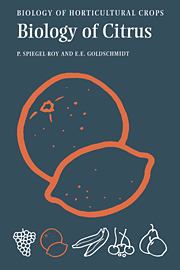1 - History and growing of citrus
Published online by Cambridge University Press: 27 October 2009
Summary
History of citrus
The term citrus originated from the Latin form of ‘Kedros’, a Greek word denoting trees like cedar, pine and cypress. As the smell of citrus leaves and fruit was reminiscent of that of cedar, the name citrus has been applied to the citron. Linnaeus grouped all citrus species known to him in the genus Citrus. In Greek mythology citrus fruits are called hesperides.
The suggested origin of the true citrus fruits is South East Asia, including South China, north-eastern India and Burma. Evidence from wild citrus in the area is still unclear. In many cases, seed has been spread large distances from the sites of origin and culture by birds, water streams and human activity. Tolkowsky (1938) considers the centre of origin to be the mountainous parts of southern China and north-eastern India, where sheltered valleys and southern slopes are protected from cold and dry winds yet are exposed to the warm rains of the summer monsoon. The deciduous Poncirus trifoliata grows wild in central and northern China.
While according to certain authors (Tanaka, 1954; Jackson, 1991) citrus fruits may have originated in north-eastern India and Burma, the introduction of citrus into cultivation and the probable origin of several species started in China. Table 2.2 gives the principal species of Citrus and their probable native habitat, according to Cooper and Chapot (1977). Lemon and grapefruit are not considered true species.
- Type
- Chapter
- Information
- The Biology of Citrus , pp. 4 - 18Publisher: Cambridge University PressPrint publication year: 1996
- 1
- Cited by



